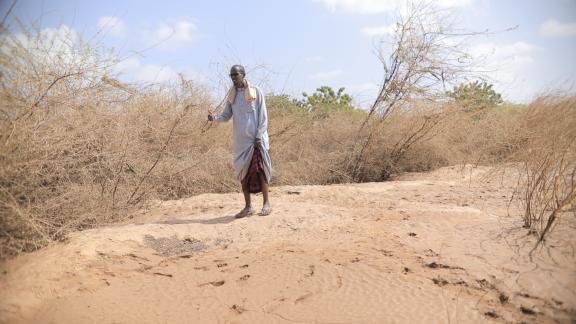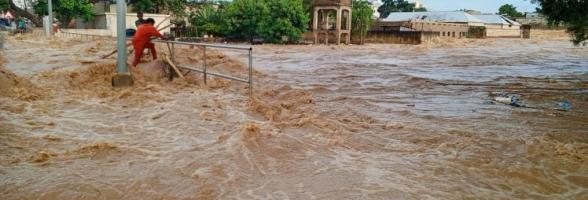As COP28 comes to a close, rich polluting nations must accelerate loss and damage compensation for countries hit hardest by climate change
Six months after a historic five-season drought, massive floods have inundated vast swaths of farmland across Kenya, Ethiopia and Somalia, right in the middle of the harvest season. Over four million impacted people in dire need of humanitarian assistance, warned Oxfam today.
The torrential rains which began in October, have killed hundreds of people, washed away thousands of homes and destroyed thousands of hectares of farmers’ crops in the three countries. Nearly two million people across the three countries have also been forced to flee their homes and farms.
In Somalia alone, the heavy Deyr (October-December) rains have killed over 100 people and devastated one-fifth of the harvest in South Central Somalia including 1,400 metric tonnes of sorghum in Juba and Shabelle have wilted. It is expected that 1.5 million hectares of farmland in Somalia will be adversely affected by the floods.
“The worsening climate crisis is a harsh reality for those already suffering hunger and destitution in East Africa. Today, millions of people are pummelled by consecutive weather extremes they are hardly responsible for, with absolutely nothing to shield them or help them rebuild their lives.” said Oxfam in Africa Director Fati N’zi-Hassane.
Adan Hassan, a farmer from Bardhere, one of the worst affected regions in Somalia told Oxfam:

“We have lost all our crops. All the tomatoes, watermelons, beans, and carrots that we would have harvested within months were all swept away. More than 80% of the bananas, lemons, and sorghum have also been destroyed. We had just started recovering and the rains have taken everything we have built in the past few months.”
In neighbouring Kenya, the unrelenting floods have affected over 500,000 people after washing away thousands of their homes, devastating over 21,000 acres of their farmland, and killing 13,500 of their livestock.
Similarly, in Ethiopia's Somali region, hundreds of thousands have been displaced. The destruction of several roads has hampered transportation and caused prices of food and basic commodities to soar.
Even before this flooding, consecutive and prolonged droughts and ongoing conflict have already caused severe food shortages and massive loss of livestock, leaving 27.4 million people across the three countries in crisis or worse levels of hunger.
“The scale and frequency of climate destruction in East Africa paints a stark picture of the abhorrent climate injustice against disadvantaged countries and communities facing climate extremes,” said Oxfam in Africa Director Fati N’zi-Hassane.
“At this year’s COP28, rich polluting nations - largely responsible for the climate crisis - must honour their obligation to provide climate finance for adaptation and loss and damage, so that East African countries can free up resources to support impacted communities adapt, recover and rebuild their lives,” added N’zi-Hassane.
Fatuma Noor | fatuma.noor@oxfam.org | +254 723944682
Simon Trépanier | simon.trepanier@oxfam.org | +39 3888 50 99 70
For updates, please follow @NewsfromOxfam and @OxfaminAfrica
- Video footage and photos from Somalia and Kenya are available to media. HERE
- Oxfam, together with and partners is scaling up humanitarian response to support affected communities affected by the floods. This includes providing food, water treatment units, hygiene kits to over thousands of people across Kenya, Somalia and Ethiopia, in addition to providing gender protection programs to the most impacted people.
- The 2023 UN Humanitarian Response Plan (HRP) requires US$2.6 billion to support 7.6 million is just 42 per cent funded.
- Food insecurity figures are based on IPC classification of the number of people in crisis or worse levels of food insecurity (IPC3+) for Kenya (1.5 million) and Somalia (4.5 million).
- Food insecurity in Ethiopia is determined by the Humanitarian Requirements Plan which estimates that in 2023, 20.1 million people were experiencing food insecurity.
- IFRC estimates that over 478,860 people in Kenya have been affected by the floods of whom over 270,00 are displaced.
- In Ethiopia, authorities report that more than 1.5 million people have been affected and over 600,000 have been displaced across seven of the country's twelve regions.
- In Somalia, OCHA reports that the number of people impacted by heavy Deyr seasonal rains and floods across Somalia has increased to over 2.4 million, according to the authorities, with over one million displaced and 110 killed in at least 36 districts.
